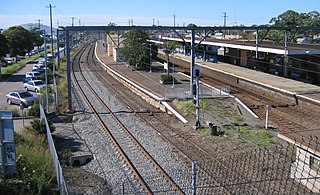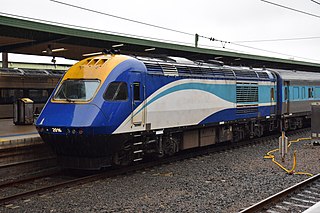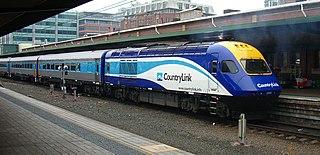
The Indian Pacific is a weekly experiential tourism passenger train service that runs in Australia's east–west rail corridor between Sydney, on the shore of the Pacific Ocean, and Perth, on the shore of the Indian Ocean – thus, like its counterpart in the north–south corridor, The Ghan, one of the few truly transcontinental trains in the world. It first ran in 1970 after the completion of gauge conversion projects in South Australia and Western Australia, enabling for the first time a cross-continental rail journey that did not have a break of gauge.

CountryLink was a passenger rail and road service brand that operated in regional areas of New South Wales, and to and from Canberra, Brisbane and Melbourne. Originally created as a business unit of the State Rail Authority of New South Wales, it later became a subsidiary of RailCorp. CountryLink operated rail services using XPT and Xplorer rolling stock, with connecting coach services operated under contract by private operators.

An autorack, also known as an auto carrier, is a specialized piece of railroad rolling stock used to transport automobiles and light trucks. Autoracks are used to transport new vehicles from factories to automotive distributors, and to transport passengers' vehicles in car shuttles and motorail services, such as Amtrak's Auto Train route.

The Main North Line is a major railway in New South Wales, Australia. It runs through Strathfield to Wallangarra. The line was the original main line between Sydney and Brisbane, however this required a change of gauge at Wallangarra. As of 1988, the line closed progressively north of Armidale with services gradually withdrawn till 2004, with the main route between Sydney and Brisbane now the North Coast line.
The State Rail Authority, a former statutory authority of the Government of New South Wales, operated and maintained railways in the Australian state of New South Wales from July 1980 until December 2003.

Broadmeadow railway station is a major regional interchange located on the Main Northern Line. The station itself serves the Newcastle suburb of Broadmeadow. The station was first opened on 15 August 1887.

The North Coast Line is the primary rail route in the Mid North Coast and Northern Rivers regions of New South Wales, Australia, and forms a major part of the Sydney–Brisbane rail corridor.

The 422 class are a class of diesel locomotives built by Clyde Engineering, Granville for the Department of Railways New South Wales in 1969/70.

The New South Wales XPT is a class of diesel-powered passenger trains built by Comeng and ABB. Based on the British Rail-designed High Speed Train, each XPT set comprises two XP power cars in a push-pull configuration and, between them, between four and seven passenger carriages. The first sets entered service under the State Rail Authority in 1982 and now operate under NSW TrainLink, running on long-distance regional and interstate North Coast, Main Western and Main Southern lines throughout New South Wales and interstate into Victoria and Queensland.

The Southern Aurora was an overnight express passenger train that operated between Australia's two largest cities, Sydney and Melbourne. First-class throughout, including the dining facilities, the Southern Aurora featured all-sleeper accommodation. The train first ran on 13 April 1962 after the opening of the North East standard gauge line from Melbourne to Albury, eliminating the break-of-gauge between the capital cities.

The Inter-Capital Daylight was a passenger train that operated between Australia's two largest cities, Sydney and Melbourne from March 1956 until August 1991.
The Sydney–Melbourne Express was an overnight intercapital passenger train service that operated between Australia's largest two cities, Sydney and Melbourne, between August 1986 and November 1993. Operated jointly by State Rail Authority and V/Line the name depended on the direction of travel, with the train nicknamed the 'Sex' or 'Mex'.

The RUB type carriage stock was a type of steel bodied air conditioned passenger carriage operated by the New South Wales Government Railways from September 1949 until April 2000.
The New South Wales stainless steel carriage stock was a type of passenger carriage operated by the New South Wales Government Railways from 1961 until 1993.

The North Coast Daylight Express was an Australian passenger train operated by the New South Wales Government Railways from November 1951 until February 1990.

The Grafton Express is an Australian passenger train operated by NSW TrainLink between Sydney and Grafton via the North Coast line.
The Brisbane Limited was an Australian passenger train operated by the New South Wales Government Railways between Sydney and Brisbane from 1888 until February 1990.
The North Coast Mail was an Australian passenger train that ran from Sydney via the North Coast line to Grafton until October 1985.

The Murwillumbah railway station is a heritage-listed former terminus railway station located on the Murwillumbah line in South Murwillumbah, in the Tweed Shire local government area of New South Wales, Australia. The former railway station is also known as the Murwillumbah Railway Station and yard group. The station opened on 24 December 1894 and closed on 16 May 2004 when the line from Casino was closed. The station was added to the New South Wales State Heritage Register on 2 April 1999.

Mullumbimby railway station was a station on the Murwillumbah line opening on 15 May 1894. It closed on 16 May 2004 when the line from Casino was closed.













